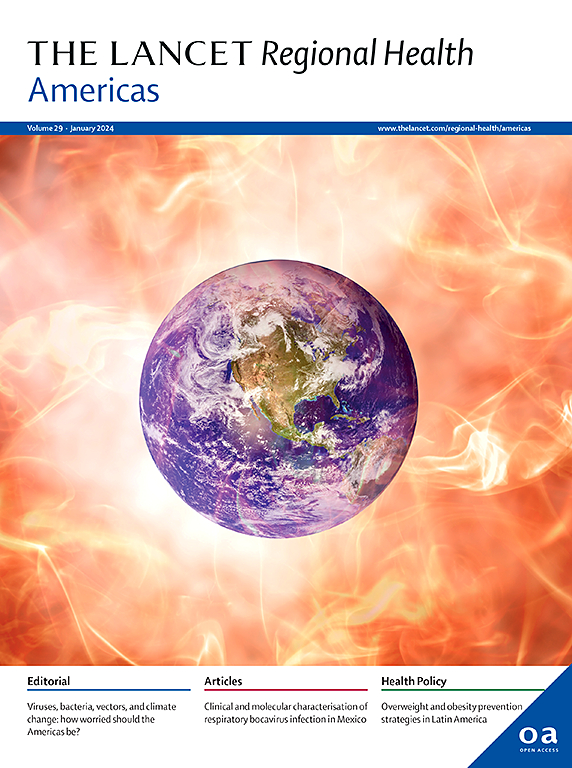Micronutrient deficiencies according to sociodemographic factors and nutritional status among Panamanian children aged six to 59 months in 2019: a cross–sectional population–based study
IF 7
Q1 HEALTH CARE SCIENCES & SERVICES
引用次数: 0
Abstract
Background
Micronutrient deficiencies have serious lifelong consequences. This study aimed to estimate the prevalence of anaemia, iron deficiency anaemia, iron deficiency, and vitamin A deficiency, according to sociodemographic factors and nutritional status among Panamanian children aged six to 59 months in 2019.
Methods
We used data from the National Health Survey of Panama (ENSPA), a population–based, cross–sectional study, with a nationally representative subsample to evaluate haemoglobin, C–reactive protein (CRP), ferritin, and retinol levels among children aged six to 59 months. The data are shown weighted.
Findings
A total of 625 children representing a population of 62,100 children (females 45.0%, 27,971/62,100; 95% CI: 37.3–53.1), aged six to 59 months were assessed. Nationally, the prevalence of anaemia was 15.5% (9604/62,100; 95% CI: 11.5–20.6), iron deficiency anaemia was 8.0% (4950/62,100; 95% CI: 5.1–12.2), iron deficiency was 26.2% (16,259/62,100; 95% CI: 20.7–32.5), and vitamin A deficiency was 3.4% (2087/62,100; 95% CI: 2.1–5.3). Children from indigenous areas exhibited a higher prevalence of all micronutrient deficiencies studied, and nationally 40.9% (2316/5656; 95% CI: 22.1–62.9) of the children with overweight/obesity exhibited at least one micronutrient deficiency.
Interpretation
Our results highlight important disparities in the prevalence of nutritional deficiencies among children in different living areas. Public health strategies should focus on these vulnerable populations, as the first years of life are crucial for adequate growth and development.
Funding
This work was supported by an institutional research grant via the Ministry of Economy and Finance of Panama (019910.002). The ENSPA study was funded by the Inter-American Development Bank.
2019年巴拿马6至59个月儿童中与社会人口因素和营养状况有关的微量营养素缺乏症:一项基于人口的横断面研究
背景微量营养素缺乏会造成严重的终身后果。本研究旨在根据社会人口因素和营养状况,估算2019年巴拿马6至59个月儿童中贫血、缺铁性贫血、缺铁和维生素A缺乏症的患病率。方法我们使用了巴拿马全国健康调查(ENSPA)的数据,这是一项基于人口的横断面研究,在全国范围内具有代表性的子样本中评估了6至59个月儿童的血红蛋白、C反应蛋白(CRP)、铁蛋白和视黄醇水平。对 6 至 59 个月大的 625 名儿童进行了评估,这些儿童代表了 62100 名儿童(女性占 45.0%,27971/62100;95% CI:37.3-53.1)。全国贫血患病率为 15.5%(9604/62100;95% CI:11.5-20.6),缺铁性贫血为 8.0%(4950/62100;95% CI:5.1-12.2),缺铁为 26.2%(16259/62100;95% CI:20.7-32.5),维生素 A 缺乏为 3.4%(2087/62100;95% CI:2.1-5.3)。在全国范围内,40.9%(2316/5656;95% CI:22.1-62.9)的超重/肥胖儿童表现出至少一种微量营养素缺乏。公共卫生策略应重点关注这些弱势群体,因为生命最初几年对于适当的生长和发育至关重要。经费来源这项工作得到了巴拿马经济和财政部机构研究基金(019910.002)的支持。ENSPA 研究由美洲开发银行资助。
本文章由计算机程序翻译,如有差异,请以英文原文为准。
求助全文
约1分钟内获得全文
求助全文
来源期刊

Lancet Regional Health-Americas
Multiple-
CiteScore
8.00
自引率
0.00%
发文量
0
期刊介绍:
The Lancet Regional Health – Americas, an open-access journal, contributes to The Lancet's global initiative by focusing on health-care quality and access in the Americas. It aims to advance clinical practice and health policy in the region, promoting better health outcomes. The journal publishes high-quality original research advocating change or shedding light on clinical practice and health policy. It welcomes submissions on various regional health topics, including infectious diseases, non-communicable diseases, child and adolescent health, maternal and reproductive health, emergency care, health policy, and health equity.
 求助内容:
求助内容: 应助结果提醒方式:
应助结果提醒方式:


